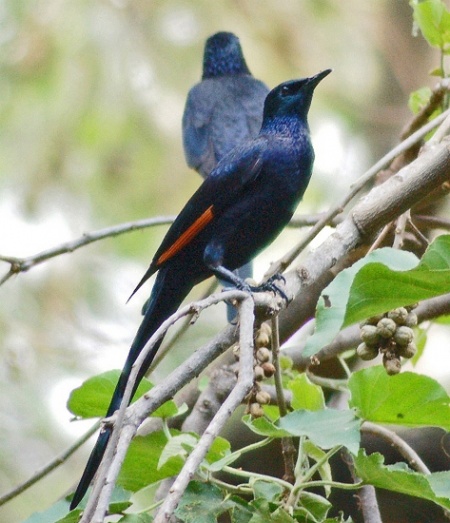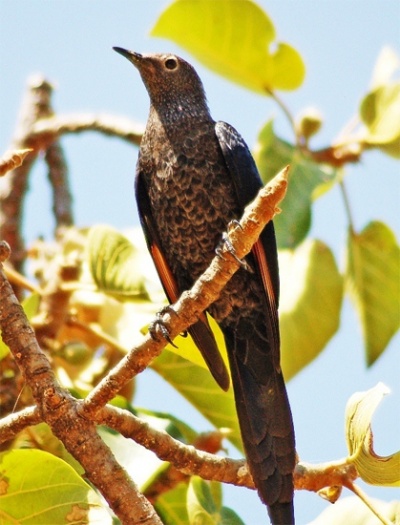Alternative name: Slender-billed Red-winged Starling
- Onychognathus tenuirostris
Identification
25 - 30cm. A dark Starling with rufous in wing.
- Purple-black plumage with greenish gloss
- Reddish-brown primaries
- Long, well graduated tail
- Slender, black bill, often with pale tip
- Hazel-brown eye
Females have duller greenish-black head with grey feather tips, dull black upperparts and dull black underparts with broad grey crescents at feather tips (producing a scalloped effect). Juveniles are sooty black with bluish wash on wings and tail.
Similar species
Slimmer than Red-winged Starling. Note also the slender bill and the graduated tail.
Distribution
Patchily distributed in the highlands of East Africa from Eritrea and Ethiopia south to Kenya, Tanzania, Uganda, Rwanda, Burundi, Democratic Republic of the Congo, Malawi and Zambia.
Locally common to very common.
Taxonomy
Onychognathus tenuirostris has two subspecies:1
- O. t. tenuirostris
- O. t. theresae
Other sources2 treat this species as monotypic.
Habitat
Montane forest from 1500m up to 3000m. Recorded up to 5000m.
Also found in lower elevations in cultivated land.
Behaviour
Diet
Feeds mainly on fruit, takes also nectar and some invertebrates.
Forages in trees. Associates with Somali Starling in Ethiopia, with Sharpe's Starling elsewhere.
Breeding
Breeding season varies in range, possibly related to water level of mountain streams. A monogamous species, breeding solitary or in small colonies. The nest is placed on the ledge of a rock face near a mountain stream or in a cave under a waterfall. Lays 2 - 4 eggs.
Movements
A mostly resident species with some local movements.
References
- Clements, JF. 2010. The Clements Checklist of Birds of the World. 6th ed., with updates to December 2010. Ithaca: Cornell Univ. Press. ISBN 978-0801445019. Spreadsheet available at http://www.birds.cornell.edu/clementschecklist/Clements%206.5.xls/view
- Del Hoyo, J, A Elliott, and D Christie, eds. 2009. Handbook of the Birds of the World. Volume 14: Bush-shrikes to Old World Sparrows. Barcelona: Lynx Edicions. ISBN 978-8496553507
Recommended Citation
- BirdForum Opus contributors. (2025) Slender-billed Starling. In: BirdForum, the forum for wild birds and birding. Retrieved 13 May 2025 from https://www.birdforum.net/opus/Slender-billed_Starling





